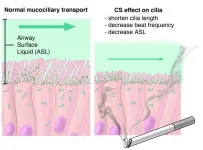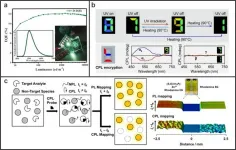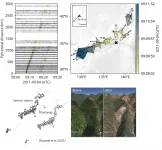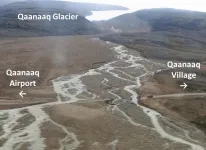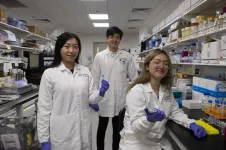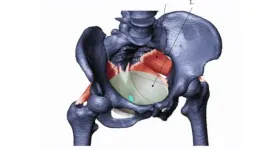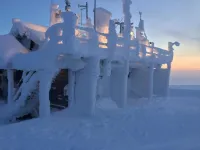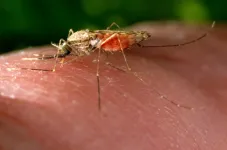INFORMATION:
Why are there relatively few aftershocks for certain cascadia earthquakes?
2021-04-13
(Press-News.org) In the Cascadia subduction zone, medium and large-sized "intraslab" earthquakes, which take place at greater than crustal depths within the subducting plate, will likely produce only a few detectable aftershocks, according to a new study.
The findings could have implications for forecasting aftershock seismic hazard in the Pacific Northwest, say Joan Gomberg of the U.S. Geological Survey and Paul Bodin of the University of Washington in Seattle, in their paper published in the Bulletin of the Seismological Society of America.
Researchers now calculate aftershock forecasts in the region based in part on data from subduction zones around the world. But Cascadia intraslab earthquakes produce fewer aftershocks compared to others in subduction zones around the world. In Cascadia, these aftershock rates are lower by more than half that of the global average, Gomberg and Bodin concluded.
They also suggest that aftershock rates for Cascadia earthquakes generally appear consistent with a "clock-advance" model, in which the mainshock causes tectonically loaded fault patches to slip earlier than they would have under the normal background seismicity of the region.
Gomberg and Bodin decided to study the phenomenon further after recent intraslab earthquakes in Mexico and Alaska produced robust aftershock sequences. "This was startling because the lore in Cascadia was that intraslab earthquakes had puny aftershock sequences," Gomberg explained, noting that in Cascadia three magnitude 6.5 to 6.8 intraslab earthquakes in 1949, 1965 and 2001 produced few to no aftershocks.
"Additionally, the USGS has begun to generate quantitatively estimated aftershock forecasts based initially on global patterns" she added, "and given these contrasting experiences, it seemed time to generate some objective numbers to base Cascadia's forecasts on."
The researchers analyzed earthquake catalogs produced by the Geological Survey of Canada and the Pacific Northwest Seismic Network from January 1985 to January 2018. Mainshocks that took place in the upper plate produced the most aftershocks, they found. Aftershock productivity was lowest for intraplate earthquakes in the Puget Lowlands portion of the subduction zone (which contains the Seattle metropolitan area), while aftershock rates were variable at the northern end of the zone near Vancouver Island and within the expected range for the southern end near Cape Mendocino.
The tectonic environment at each end of the subduction zone could help explain why aftershock production is higher there, the researchers said. Multiple plate boundaries meet in these areas, which could "concentrate stress, so more faults exist and are closer to failure than in other areas," they noted.
The reasons why Cascadia aftershock production is so low compared to global rates are still unclear, but "one strong possibility would seem to be that temperature for the deeper slab earthquakes is a dominant controlling parameter," said Bodin, noting that "the young, hot Juan de Fuca plate is being jammed beneath North America" in Cascadia.
The deeper the earthquake, the higher the temperatures, and the researchers did find that aftershock productivity decreases with depth, Bodin explained. "However, this is not so different than southern Mexico, where, as we noted, recent intraslab mainshocks have supported vigorous aftershock sequences."
Gomberg and Bodin said their analysis was limited by the fact that seismicity rates in Cascadia are generally low and there are sparse data to constrain the location and depth of most earthquakes in the region. Methods that help researchers detect and locate smaller earthquakes could provide a better sense of overall aftershock rates and the physical processes that control them, they suggested.
ELSE PRESS RELEASES FROM THIS DATE:
Amoeba biology reveals potential treatment target for lung disease
2021-04-13
In a series of experiments that began with amoebas -- single-celled organisms that extend podlike appendages to move around -- Johns Hopkins Medicine scientists say they have identified a genetic pathway that could be activated to help sweep out mucus from the lungs of people with chronic obstructive pulmonary disease a widespread lung ailment.
"Physician-scientists and fundamental biologists worked together to understand a problem at the root of a major human illness, and the problem, as often happens, relates to the core biology of cells," says Doug Robinson, Ph.D., professor of cell ...
Circularly polarized luminescence from organic micro-/nano-structures
2021-04-13
Circularly polarized light exhibits promising applications in future displays and photonic technologies. Traditionally, circularly polarized light is converted from unpolarized light by the linear polarizer and the quarter-wave plate. During this indirectly physical process, at least 50% of energy will be lost. Circularly polarized luminescence (CPL) from chiral luminophores provides an ideal approach to directly generate circularly polarized light, in which the energy loss induced by polarized filter can be reduced. Among various chiral luminophores, organic micro-/nano-structures have attracted increasing attention owing to the high quantum efficiency ...
Tremors triggered by typhoon talas tell tales of tumbling terrain
2021-04-13
Tsukuba, Japan - Tropical cyclones like typhoons may invoke imagery of violent winds and storm surges flooding coastal areas, but with the heavy rainfall these storms may bring, another major hazard they can cause is landslides--sometimes a whole series of landslides across an affected area over a short time. Detecting these landslides is often difficult during the hazardous weather conditions that trigger them. New methods to rapidly detect and respond to these events can help mitigate their harm, as well as better understand the physical processes themselves.
In a new study published in Geophysical Journal International, a research team led ...
Modeling past and future glacial floods in northern Greenland
2021-04-13
Hokkaido University researchers have clarified different causes of past glacial river floods in the far north of Greenland, and what it means for the region's residents as the climate changes.
The river flowing from the Qaanaaq Glacier in northwest Greenland flooded in 2015 and 2016, washing out the only road connecting the small village of Qaanaaq and its 600 residents to the local airport. What caused the floods was unclear at the time. Now, by combining physical field measurements and meteorological data into a numerical model, researchers at Japan's Hokkaido ...
"Shedding light" on the role of undesired impurities in gallium nitride semiconductors
2021-04-13
The semiconductor industry and pretty much all of electronics today are dominated by silicon. In transistors, computer chips, and solar cells, silicon has been a standard component for decades. But all this may change soon, with gallium nitride (GaN) emerging as a powerful, even superior, alternative. While not very heard of, GaN semiconductors have been in the electronics market since 1990s and are often employed in power electronic devices due to their relatively larger bandgap than silicon--an aspect that makes it a better candidate for high-voltage and high-temperature applications. Moreover, current travels quicker through GaN, which ensures fewer switching losses during switching applications.
Not everything about GaN is perfect, however. While impurities are usually desirable ...
NTU Singapore study investigates link between COVID-19 and risk of blood clot formation
2021-04-13
People who have recovered from COVID-19, especially those with pre-existing cardiovascular conditions, may be at risk of developing blood clots due to a lingering and overactive immune response, according to a study led by Nanyang Technological University, Singapore (NTU) scientists.
The team of researchers, led by NTU Assistant Professor Christine Cheung, investigated the possible link between COVID-19 and an increased risk of blood clot formation, shedding new light on "long-haul COVID" - the name given to the medium- and long-term health consequences of COVID-19.
The findings may help to explain why some people who have recovered from COVID-19 exhibit symptoms of blood clotting complications after their initial recovery. In some cases, they are at increased risk of heart attack, ...
Childbirth versus pelvic floor stability
2021-04-13
Evolutionary anthropologists from the University of Vienna and colleagues now present evidence for a different explanation, published in PNAS. A larger bony pelvic canal is disadvantageous for the pelvic floor's ability to support the fetus and the inner organs and predisposes to incontinence.
The human pelvis is simultaneously subject to obstetric selection, favoring a more spacious birth canal, and an opposing selective force that favors a smaller pelvic canal. Previous work of scientists from the University of Vienna has already led to a relatively good understanding of this evolutionary "trade-off" and how it results in the high rates of obstructed labor in modern humans. ...
Snow chaos in Europe caused by melting sea-ice in the Arctic
2021-04-13
They are diligently stoking thousands of bonfires on the ground close to their crops, but the French winemakers are fighting a losing battle. An above-average warm spell at the end of March has been followed by days of extreme frost, destroying the vines with losses amounting to 90 percent above average. The image of the struggle may well be the most depressingly beautiful illustration of the complexities and unpredictability of global climate warming. It is also an agricultural disaster from Bordeaux to Champagne.
It is the loss of the Arctic sea-ice due to climate warming that has, somewhat paradoxically, been implicated with severe cold and snowy mid-latitude winters.
"Climate change doesn't always manifest in the most ...
Simple genetic modification aims to stop mosquitoes spreading malaria
2021-04-13
Altering a mosquito's gut genes to make them spread antimalarial genes to the next generation of their species shows promise as an approach to curb malaria, suggests a preliminary study published today in eLife.
The study is the latest in a series of steps toward using CRISPR-Cas9 gene-editing technology to make changes in mosquito genes that could reduce their ability to spread malaria. If further studies support this approach, it could provide a new way to reduce illnesses and deaths caused by malaria.
Growing mosquito resistance to pesticides, as well as malaria parasite resistance ...
Consumers are willing to pay for ecosystem services
2021-04-13
Many consumers are willing to pay for improved environmental quality and thus non-market values of impacts of food production on e.g. water quality, C sequestration, biodiversity, pollution, erosion or GHG emissions may even be comparable to the market value of agricultural production. Diverfarming project elucidated how consumers value agroecosystem services enabled by diversification and provided consumer perspectives for developing future agricultural and food policies to better support cropping diversification.
The researchers quantified consumers' willingness to pay for the benefits of increased farm and regional scale diversity of cultivation practices and crop rotations. Three valuation scenarios were presented to a ...
